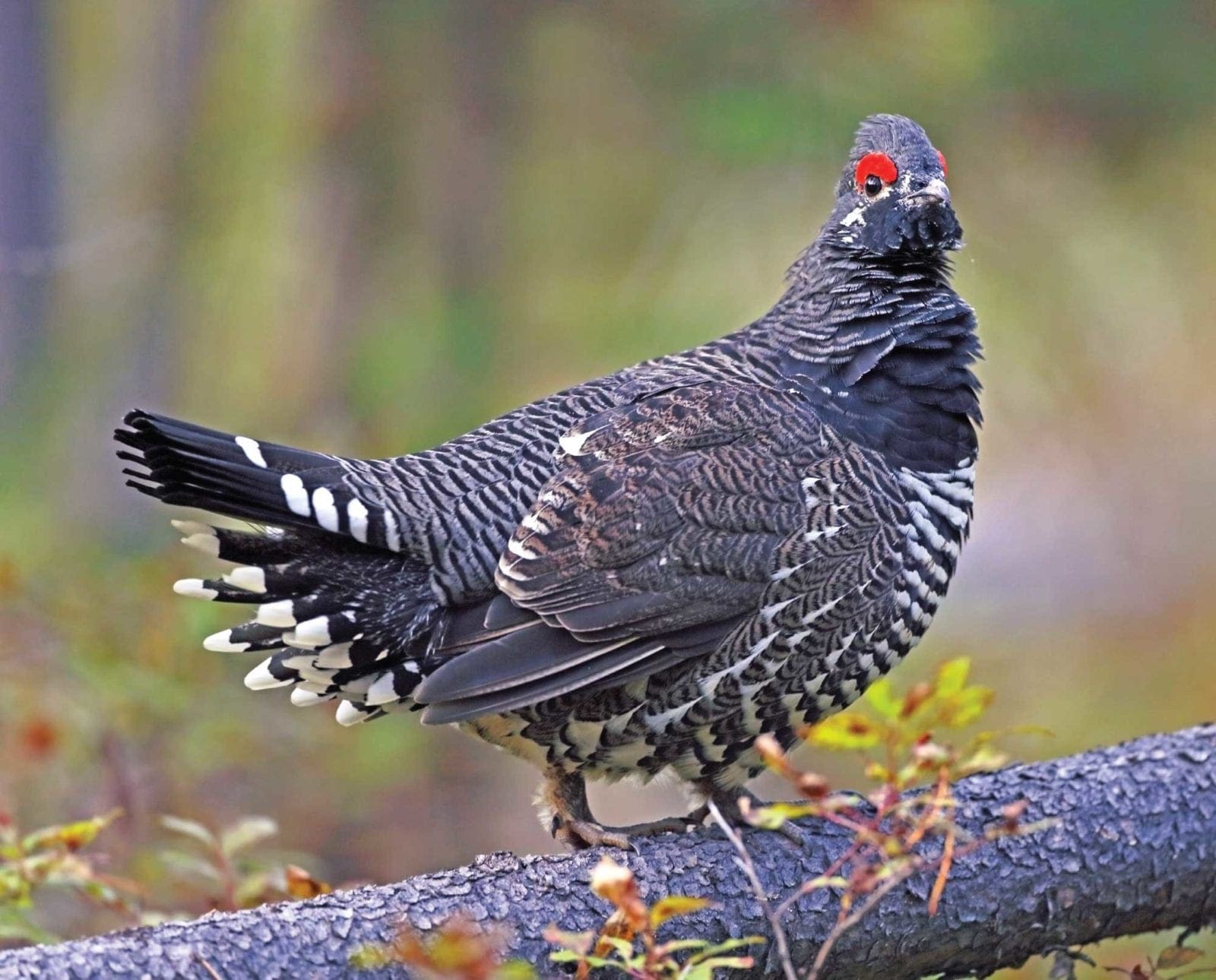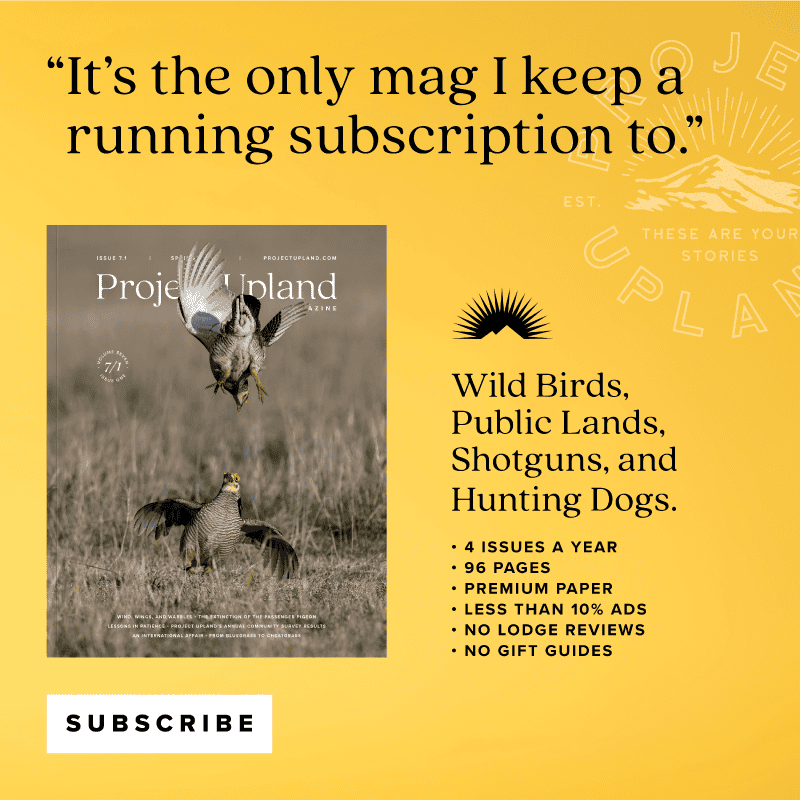Home » Grouse Species » Spruce Grouse Hunting » Spruce Grouse (Falcipennis canadensis) – An Upland Game Bird Profile
Spruce Grouse (Falcipennis canadensis) – An Upland Game Bird Profile
- Climate Change Impact (Audubon) | +1.5°C - 50% Range Lost | +3.0°C - 86% Range Lost

Ryan Lisson is a biologist and regular content contributor to…
Take a look at the Spruce Grouse (Falcipennis canadensis) its history, biology, and hunting availability.
If you don’t live in the northern fringe of the country, it’s fairly safe to say that you’re not too familiar with the spruce grouse. Maybe you haven’t even heard of it before. If so, that’s a shame. This mysterious bird of the North Country is well worth your attention. Here’s what you need to know about them.
Description and Life History
The spruce grouse is part of the grouse family, weighs approximately 1 to 1 1/2 pounds and is about the same size, or smaller than, a ruffed grouse. The hens are mottled brown, gray, and white. They’ll can also disappear just like a ruffy in the woods. But the males have darker black feathers with prominent white bands/spots and display a jarring red patch called a “comb” above their eye. They also have feather-covered legs.
Like the ruffed grouse, its avian cousin, males court females in the spring by puffing their feathers out and strutting for the hens. They will also drum by beating their wings, but it is not nearly as pronounced as with ruffed grouse. In fact, the spruce grouse tends to prefer secrecy and solitude more than any other native North American grouse species.
Hens produce small clutches of approximately six eggs. They build nests of feather and needle-covered ground. The chicks will stay with their mother for several weeks to a couple months, consuming mostly high-protein insects during that time. Yet, they can fly and are fairly self-sufficient within a few weeks of life. Adults forage for berries, insects, and buds during the spring and summer and resort to needles in the winter. Natural predators of the spruce grouse include goshawks, owls, foxes, coyotes, weasels, fishers, and martens.
Range and Habitat
They are primarily a boreal forest bird found throughout Canada and Alaska. But they hit the southern end of their range down into the far northern edge of the states, including New England, the upper Midwest states, and Montana over to Washington. The New England area has faced decades if not centuries of heavy timber harvests that have drastically reduced the available habitat for the grouse. As a result, many states place them on threatened or special concern lists instead of wild game lists. On the other hand, you can hunt spruce grouse in Minnesota. The population is still fairly stable and the habitat is abundant. Annual harvests, however, are a very small percentage of the annual ruffed grouse harvest. The ratio is about 10-20,000 spruce grouse to about 500,000 or more ruffed grouse.
Hunting spruce grouse out west is another story. In Washington, spruce grouse can be hunted in remote mountain forests instead of the lowlands of the Midwest or Northeast. They will also accept less cover at these elevations, provided there are still the necessary habitat and food features it needs.
As their name implies, spruce grouse require middle-aged conifer forests, especially the short-needled spruce, fir, or pine species to really thrive. Yet a mixed northern forest type with conifers and deciduous trees can also be sufficient. More importantly, they require a patchwork of different aged forest types to fulfill their annual needs. Dense live understories and the presence of berries, especially blueberries, are important habitat indicators. Their preference for uninhabited and wild places, along with their secretive nature, makes them a difficult bird to find.
Spruce grouse are year-round residents, meaning they are non-migratory. In winter, they generally transition to feeding in tree tops and hiding in snow burrows at night to stay warm. They can store a lot of food in their crop, which their gizzards will digest later when they are resting securely again from predators.
Conservation Issues
While you can hunt them in a few states, they are imperiled or sensitive in a few others. Since these birds are naturally not afraid of people, it’s easy to see how unethical hunting practices or high hunting pressure could quickly make a local dent in the population. There’s a reason why they’re called “fool’s hens.” They rarely flush in some locales, relying instead on their camouflage to hide from predators. If they do flush, most of them will fly straight up into a nearby tree to watch the strange visitor to their remote part of the forest. The die-hard wing shooter won’t find much satisfaction hunting spruce grouse in that regard.
Some hunters also say that older birds taste a lot like the pine needles they consume over the winter. Or turpentine. In either case, the taste puts many people off from hunting them at all. But younger birds who have only fed on insects, berries, and other green vegetation shouldn’t have any off-flavors like that.
The largest conservation issue affecting their populations overall is habitat loss. Housing or commercial development, fire suppression, and even some forestry practices have reduced the presence of middle-aged or mature spruce-fir forests across their range, most notably in the Northeast. After many conifer forests are harvested, they will often regenerate into aspen/birch or hardwood species. That kind of early successional forest is great for ruffed grouse and woodcock, but it’s not good habitat for these grouse.
The opposite is also true. Some forests have matured to the point where they no longer offer benefits to these birds. The understories are too open to provide adequate nesting cover for them. Replanting sites to short-needled conifers, allowing prescribed or wild fires in some remote areas, and designating corridors of habitat where these grouse can thrive is critical to keeping their range within American borders. If not, they will drift north into Canada like the moose or caribou have done, taking something special away with them.
Hunting Opportunities
The spruce grouse is only listed as a game bird you can hunt in a handful of states (see below). Their range has shifted northward as habitats disappear. In the mountainous terrain of pretty much every state below but Minnesota, you can find spruce grouse in sub-alpine areas with lodgepole pine, Engelmann spruce, and firs. In Minnesota, they are more associated with northern lowland areas, including black spruce and tamarack swamps, and some upland areas adjacent to them with a white spruce and jack pine component. Note that some of the states below have several hunting units with different seasons and bag limits, so the exact dates and daily limit may be different depending on where you hunt.
| State | Season | Bag Limit |
| Alaska | Various units, August 1-May 15 | 15 |
| Idaho | August 30-January 31 | 4 |
| Minnesota | September 16-January 1 | 5 |
| Montana | September 1-January 1 | 3 |
| Washington | September 1-December 31 | 3 |
Sources:
Natureserve. 2017. NatureServe Explorer: An online encyclopedia of life. Accessed at http://explorer.natureserve.org
The Cornell Lab of Ornithology. 2017. All About Birds. Available at https://www.allaboutbirds.org/guide/Spruce_Grouse/lifehistory
Ryan Lisson is a biologist and regular content contributor to several outdoor manufacturers, hunting shows, publications, and blogs. He is an avid small game, turkey, and whitetail hunter from northern Minnesota and loves managing habitat almost as much as hunting. Ryan is also passionate about helping other adults experience the outdoors for their first time, which spurred him to launch Zero to Hunt, a website devoted to mentoring new hunters.





